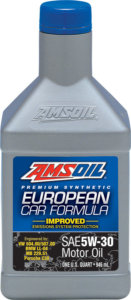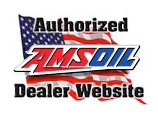20 Jun Why European Cars Use Special Motor Oil
Owning a European car comes with challenges, but finding the right motor oil doesn’t have to be one of them.
European car require a different motor oil than what you would use in your Ford, Chevy or Dodge. I want to talk about those differences and how Amsoil offers a solution for European car owners.
Strict emissions standards For European Cars
European Union maintains more strict standards from carbon dioxide (CO2) and carbon monoxide (CO) emissions than the U.S. do. Our standards for nitrogen oxides (NOx) and particular matter (PM) are more strict. Modern diesels emit lower carbon dioxide than gasoline engines, the European car market turned toward the increased use of diesels in the 1990s. Diesels also provide better fuel economy.
One drawback however is the higher level of NOx and PM diesels produce. To counter-act this, diesel powered European vehicles are equipped with diesel particulate filters (DPF) and catalysts designed to reduce tailpipe emissions.
Here’s where motor oil comes into play. In oil’s formulation can have a negative effect on sensitive emissions control devices. Certain components in the motor oil formulation, such as sulfated ash, phosphorus and sulfur (known collectively as SAPS), can reduce the life of DPF’s and other emission devices. For that reason, motor oils formulated for European vehicles often contain lower SAPS levels to protect the emissions control systems.
Longer oil change intervals
European automakers have recommended longer oil changes intervals for years. In the US and Canada, the traditional 3000 mile oil change is still here.
Europeans are accustomed to changing oil far less often with drain intervals of 16,000 km (10,000 miles) or so. One reason is a higher cost of motor oil in Europe. Another is the difference between manufacturer recommend. For example, oil changes for 1999 -t 2013 BMWs are required every 15,000 miles.
Longer drain intervals common with European cars requiring oil capable protect against wear, deposits and sludge for the duration, which requires a more robust oil.
Viscosity differences
Check the owner’s manual for which viscosity oil to use and you’ll likely find a chart the suggested different viscosities for different operating temperature ranges. In cold weather, the OEM may recommend 5W-30. In warm weather, by 5W-40. Traditionally, drive a settle on 0W-40 or 5W-40 to offer the best of both worlds- good cold flow at startup to protect against wear and good heat resistance once operating temperatures are reached.
OEM approvals
Staying with your car’s manual, the OEM also recommends oil that meets a specific performance standard. A  Volkswagen owner, for example, must use an oil that meets the requirements of Volkswagens owners performance specs. The same holds true the same holds true for Mercedes, BMW, Porsche and other European cars.
Volkswagen owner, for example, must use an oil that meets the requirements of Volkswagens owners performance specs. The same holds true the same holds true for Mercedes, BMW, Porsche and other European cars.
Complicating matters, each OEM motor oil specification is slightly different. One OEM motor oil spec may require oils that offer better performance against oxidation, while another may require better resistance to viscosity loss. OEM specifications tend to be more strict and require better motor oil performance that the industry specs we’re used to in the United States and Canada such as API SN plus or ILSAC GF–5. This of course requires more advancing, typically expensive, motor oil technology delivered almost exclusively by synthetics.
All these differences can confuse your customers on which oils to use. Fortunately, Amsoil remove the guesswork without Synthetic European car formula motor oil line. It specifically formulated to meet the strict emission requirements, viscosities needs and OEM performance specifications of today’s sophisticated European vehicles.

